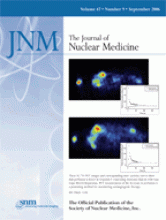TO THE EDITOR: In a recent paper (1), Brechtel et al. evaluated the impact of different CT acquisition protocols on imaging with an integrated PET/CT scanner. We fully acknowledge that breathing protocols and accurate image registration in PET/CT are highly relevant and require adequate evaluation. Brechtel et al. analyzed the relationship between various breathing protocols and the accuracy of PET/CT image registration. We believe that the applied methodology merits some comments.
The evaluation of image registration in hybrid PET/CT is a delicate matter. When CT images are used for correction of photon attenuation in PET images, the 2 imaging modalities are no longer independent. Artifacts in attenuation-corrected PET images may be caused by differences in the attenuation of low-energy CT photons and high-energy PET photons or by positional differences in attenuating masses during the acquisition of CT and PET images. The latter plays an important role in the diaphragmatic area, where a sharp change in tissue density exists that may have shifted between the PET acquisition and the CT acquisition. The result of this phenomenon is that—in hybrid PET/CT—the CT image defines the visual position of the diaphragm on the attenuation-corrected PET image rather than correlates with it. This may lead to clinically relevant problems such as apparent displacement of the diaphragm (2,3) or even the disappearance of lesions (4). As a consequence, correlation of CT images only with uncorrected PET images allows evaluation of image registration in the diaphragmatic area. This applies a fortiori when evaluating the position of liver borders and, unabatedly, when performing software image fusion between PET from a hybrid scanner and CT.
Brechtel et al. (1) appear to have analyzed PET/CT image registration by determination of liver borders on attenuation-corrected PET images. Consequently, their evaluation suffers from bias because of attenuation correction artifacts, as can be recognized in their results. For example, the authors stated that the average image registration error in the diaphragmatic area was only 6.2 mm (range, 3.2–9.4 mm) when they used an unforced expiration breath-hold protocol in single-phase CT. Such accuracy in intentional positioning of the diaphragm by breathing commands can hardly be expected from living subjects. In our experience, correlation of CT images and uncorrected PET images can reveal much larger errors. This was also recognized in a comparable analysis by Goerres et al., who found differences in diaphragmatic position of −24.7 to 18.9 mm in the vertical direction (5). The same reasoning holds when free-breathing CT is used for attenuation correction. Brechtel et al. stated an average error of 9.4 mm (range, 5.7–12.1 mm), whereas Goerres et al. reported differences of −29.1 to 18.9 mm. Therefore, it is likely that the presented results were caused by evaluation of attenuation-corrected PET images containing artifacts.
In another protocol, Brechtel et al. (1) presumed that PET images that had been corrected for attenuation using free-breathing CT images were suitable for correlation with breath-hold multiphase CT images, or with a different set of free-breathing multiphase CT images, after software fusion. Evaluation of image registration between such image sets will undoubtedly be affected by attenuation correction artifacts.
In conclusion, the applied methodology and the subsequent results are not straightforward. If the results were indeed derived from analysis of attenuation-corrected PET data, reanalysis using the uncorrected PET data will provide more realistic (and probably less encouraging) results for the accuracy of PET/CT image registration. The effects of the attenuation correction procedure itself are not negligible and can be analyzed separately.
Footnotes
-
COPYRIGHT © 2006 by the Society of Nuclear Medicine, Inc.







